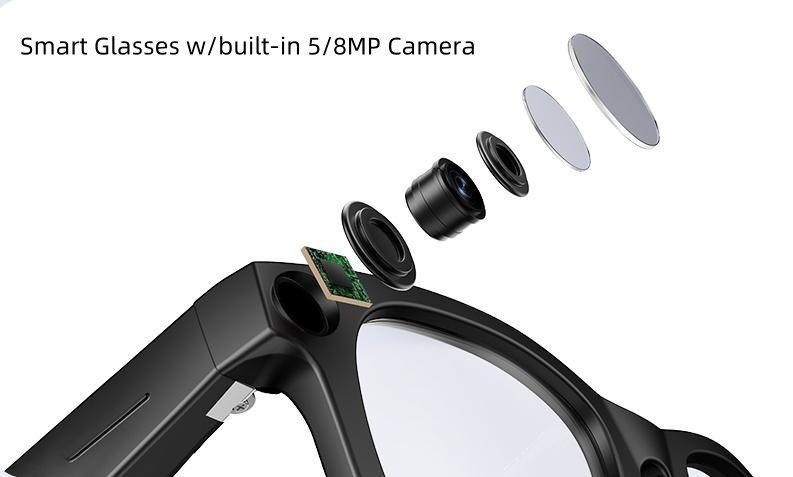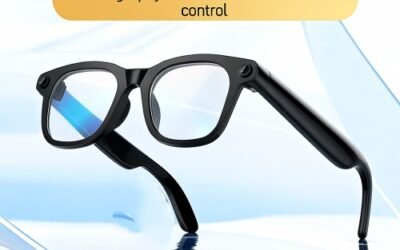The AI Glasses Market Is Exploding – And Everyone’s Joining the Fight
By 2025, one consensus has solidified across the tech industry: AI glasses are entering a phase of explosive growth. In the first half of the year alone, nearly 30 new AI glasses models were released. According to a JD.com mid-year report published on August 26, transaction volume for smart glasses grew tenfold year-over-year, while the number of brands offering such devices tripled.
This surge confirms the market’s vitality. Despite some skeptical voices, companies are charging ahead—preparing for the next phase of competition in the AI glasses arena.
In Q4 2025, close to 10 more new products are slated for release. Among them, the solution presented by DPVR stands out as particularly compelling. As brands race to define the future of AI glasses—focusing on AI integration, use cases, and applications—DPVR has revealed a clear and thoughtful product roadmap.
Q4 2025: The Next Peak in the AI Glasses Battle
The AI glasses market remains white-hot. IDC data shows that global smart glasses shipments reached 2.555 million units in Q2 2025, a 54.9% increase year-over-year. The Chinese market performed even more impressively, with shipments of 664,000 units—a staggering 145.5% growth.
Market research firms are universally optimistic about the AI glasses segment, projecting tens of times growth over the next five to six years. 2026 is expected to be a critical breakout year, with the market reaching $3–5 billion. China’s share of the global market is forecast to rise from 20% in 2024 to 40% by 2030, making it the core driver of worldwide growth.
Over the past year, China’s AI glasses market has not only sparked a “Hundred Glasses War” but also attracted a diverse array of players—from Xiaomi, Alibaba, and ByteDance to specialized XR companies like Rokid, Thunderbird, and DPVR. Established giants and agile innovators alike are targeting this space.
Almost overnight, AI glasses have become a must-enter category for tech companies. In the first half of 2025, AR/VR-focused manufacturers led the charge in new product releases. Thanks to their efforts, this once-niche tech product is now entering the mainstream.
Walk through any major shopping mall or eyewear retailer in China, and you’ll find smart glasses on display. As the market expands, a tug-of-war has emerged: leading companies and new entrants are leveraging their respective strengths in technology, branding, and distribution to capture market share.
Major domestic players are using their brand and supply chain advantages to target the mass market, quickly launching products priced around ¥1,000 to attract young consumers. Meanwhile, specialized XR companies like Rokid, Thunderbird, and DPVR are carving out niches with differentiated product lines. DPVR’s recently launched AI glasses, for example, focus on outdoor photography, emphasizing functions like recording, reflection, dialogue, and reminders.
The Role of Specialized OEMs Like ZhuoHao Technology
While the future of AI glasses is widely seen as the next consumer gateway—potentially succeeding smartphones—the industry still faces challenges in wearability, functional utility, and supply chain maturity.
This is where specialized manufacturers like ZhuoHao Technology become essential. As a seasoned smart glasses manufacturer and OEM/ODM provider, ZhuoHao enables brands to overcome these hurdles through:
- Lightweight structural design
- Audio-acoustic integration
- Battery and thermal optimization
- Mass production readiness
By partnering with an experienced OEM like ZhuoHao, companies can accelerate time-to-market, reduce R&D risks, and ensure product quality—critical advantages in a fast-moving, competitive landscape.
DPVR’s AI Glasses: A Case Study in Practical Innovation
As a veteran AR/VR player, DPVR has built a strong reputation since its founding in 2015. Over the past decade, the company has accumulated hundreds of invention patents, 114 trademarks, and 11 software copyrights. It has been listed among “China’s Top 50 VR Companies” for seven consecutive years and ranks among the global leaders in VR hardware.
This solid technological foundation and market experience gave DPVR the confidence to enter the AI glasses space. Its newly released AI glasses merge first-person video recording, AI interaction, and lightweight design—positioning the product as one of the most practical and cost-effective smart tech devices of the second half of 2025.
Designed to Be Worn – and Seen
AI glasses are worn on the face, making them deeply personal. Unlike smartphones, where style is secondary, appearance plays a decisive role in the AI glasses purchase decision. DPVR tackled this challenge head-on, designing its glasses with a classic sunglasses silhouette, available in matte black, glossy black, and transparent frames. Weighing just 46 grams and optimized for Asian facial structures, they’re built for all-day comfort.
An Imaging System Built for First-Person Perspective
For outdoor use, DPVR integrated a professional imaging system featuring a Sony IMX681 sensor, 12-megapixel custom lens, and F2.2 aperture. With EIS electronic stabilization, distortion correction, and HDR processing, the glasses deliver stable, high-quality footage even during running, cycling, or travel.
The device also simplifies sharing: users can generate and post short videos directly to social platforms without exporting or editing—a major convenience for outdoor enthusiasts.
AI That Understands You
At the heart of the experience is DPVR’s AI assistant, “Sunny,” which supports voice interaction, real-time translation, automatic travelogue generation, image recognition, weather updates, memos, and meeting summaries. The glasses feature symmetrical dual speakers and anti-soundfield leakage technology, ensuring clear dialogue even in noisy outdoor environments.
An interesting addition is the “AI Active Photographer” mode, which automatically captures beautiful moments while the user stays immersed in the experience. Priced accessibly at just over ¥1,000, DPVR’s glasses offer a compelling entry point for consumers new to AI eyewear.
The Road Ahead: An Ecosystem Battle
The future of AI glasses remains bright. Industry data shows that Ray-Ban Meta sales surpassed 2 million units by February 2025, with projections of 5 million by year-end. By 2026, the brand aims to ramp annual production capacity to 10 million units.
Ray-Ban Meta’s success has inspired manufacturers worldwide—and intensified competition across the Chinese market. As the battle heats up, supply chain strength and software-hardware integration will become decisive factors.
This is where experienced OEM partners like ZhuoHao Technology provide a critical edge. With expertise in optical assembly, audio tuning, and compact electronics integration, ZhuoHao helps brands like DPVR accelerate development, enhance performance, and scale production—without compromising on quality or design.
For AR/VR companies transitioning into AI glasses, this manufacturing partnership is especially valuable. DPVR’s decade of experience in hardware and content ecosystems gives it a natural advantage—one that’s amplified by collaboration with a specialized smart glasses OEM.
Conclusion: A Market of Many Winners
The AI glasses revolution is well underway. As DPVR and others have shown, success in this space requires a blend of technical depth, user-centric design, and supply chain agility.
With experienced OEM providers like ZhuoHao Technology supporting the industry’s rapid expansion, the market is poised for continued innovation—and growth. In the coming years, we can expect not one winner, but many, as brands and manufacturers work together to bring AI eyewear into the daily lives of millions.
Interested in launching your own AI glasses line? Partner with ZhuoHao Technology—the OEM expert behind some of the industry’s most advanced smart eyewear products.




0 Comments